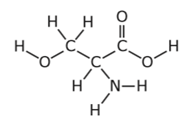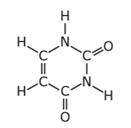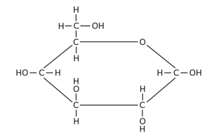
BR 56 -Biomolecules & Enzymes
Quiz
•
Biology
•
8th - 10th Grade
•
Practice Problem
•
Medium
Standards-aligned
Used 356+ times
FREE Resource
Enhance your content in a minute
18 questions
Show all answers
1.
MULTIPLE CHOICE QUESTION
2 mins • 1 pt
Proteins and polysaccharides are polymers. These polymers are formed by dehydration synthesis. Which statement correctly identifies a difference in the structure of proteins and polysaccharides?
Only polysaccharides are made of repeating units of cytosine, adenine, guanine, and thymine.
Only proteins are formed from amino acids joined by peptide bonds.
Only polysaccharides can be folded and twisted to very specific shapes.
Only proteins can be large molecules with thousands of subunits.
2.
MULTIPLE CHOICE QUESTION
45 sec • 1 pt
Which of these best represents a fatty-acid molecule?




3.
MULTIPLE CHOICE QUESTION
1 min • 1 pt
Overheating an enzyme results in the enzyme’s loss of —
net electrical charge
ability to catalyze a reaction
storage of a large amount of chemical energy
storage of inherited information
Tags
NGSS.HS-PS1-5
4.
MULTIPLE CHOICE QUESTION
1 min • 1 pt
Which of the following biological molecules is correctly paired with one of the functions it primarily serves in living cells?
nucleic acids - store genetic information
lipids - catalyze chemical reactions
carbohydrates - component of cytoskeleton
proteins - long term energy storage
5.
MULTIPLE CHOICE QUESTION
2 mins • 1 pt
In red blood cells, the compound carbonic anhydrase increases the rate at which carbon dioxide is converted to bicarbonate ions for transport in the blood. In red blood cells, carbonic anhydrase acts as which of the following?
an enzyme
a hormone
a lipid
a sugar
6.
MULTIPLE CHOICE QUESTION
1 min • 1 pt
Which best describes how enzymes function in the body?
Enzymes are converted into products by the reactions they catalyze.
Enzymes lower the activation energy of reactions.
One enzyme can catalyze many different reactions.
An enzyme is used once and then destroyed by the cell.
7.
MULTIPLE CHOICE QUESTION
1 min • 1 pt
Which statement describes the major role of lipids within a cell?
They cause DNA to replicate.
They move RNA in the cytoplasm.
They catalyze chemical reactions in the cell.
They are the main components of membranes.
Create a free account and access millions of resources
Create resources
Host any resource
Get auto-graded reports

Continue with Google

Continue with Email

Continue with Classlink

Continue with Clever
or continue with

Microsoft
%20(1).png)
Apple
Others
Already have an account?
Similar Resources on Wayground

13 questions
Plant Structure & Function
Quiz
•
9th - 10th Grade

15 questions
Biodiversity and Sustainability
Quiz
•
4th - 12th Grade

22 questions
Mitosis
Quiz
•
9th - 12th Grade

15 questions
SB3a Law of Dominance Quiz
Quiz
•
9th - 10th Grade

16 questions
Medical Math Review
Quiz
•
6th Grade - University

17 questions
Steele HS Biology Midterm 2023 Review #3
Quiz
•
9th Grade

16 questions
Predicting Genetic Outcomes
Quiz
•
9th Grade

14 questions
Y11 placenta, amniotic fluid and other
Quiz
•
9th Grade
Popular Resources on Wayground

25 questions
Multiplication Facts
Quiz
•
5th Grade

15 questions
4:3 Model Multiplication of Decimals by Whole Numbers
Quiz
•
5th Grade

10 questions
The Best Christmas Pageant Ever Chapters 1 & 2
Quiz
•
4th Grade

12 questions
Unit 4 Review Day
Quiz
•
3rd Grade

20 questions
Christmas Trivia
Quiz
•
6th - 8th Grade

18 questions
Kids Christmas Trivia
Quiz
•
KG - 5th Grade

14 questions
Christmas Trivia
Quiz
•
5th Grade

15 questions
Solving Equations with Variables on Both Sides Review
Quiz
•
8th Grade
Discover more resources for Biology

20 questions
Cell organelles and functions
Quiz
•
10th Grade

20 questions
Punnett Squares and Genetics
Quiz
•
9th Grade

25 questions
photosynthesis and cellular respiration
Quiz
•
9th Grade

20 questions
Stages of Meiosis
Quiz
•
9th - 12th Grade

20 questions
DNA & Protein Synthesis
Quiz
•
9th Grade

25 questions
The Cell Cycle and Mitosis
Quiz
•
9th Grade

20 questions
23 Protein Synthesis Review
Quiz
•
9th Grade

20 questions
AP Biology: Unit 3 Review (CED)
Quiz
•
9th - 12th Grade
